【沪教牛津版(三起)】六年级下册英语教案unit2Changesinourlives(最新整理)
- 格式:pdf
- 大小:170.12 KB
- 文档页数:8
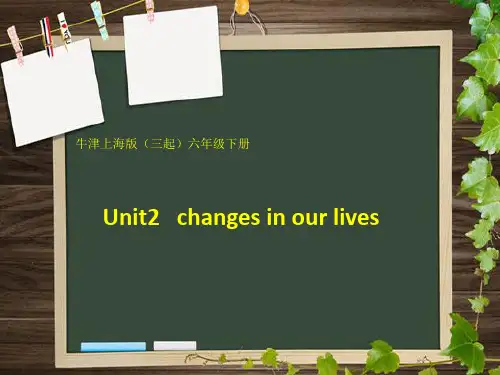
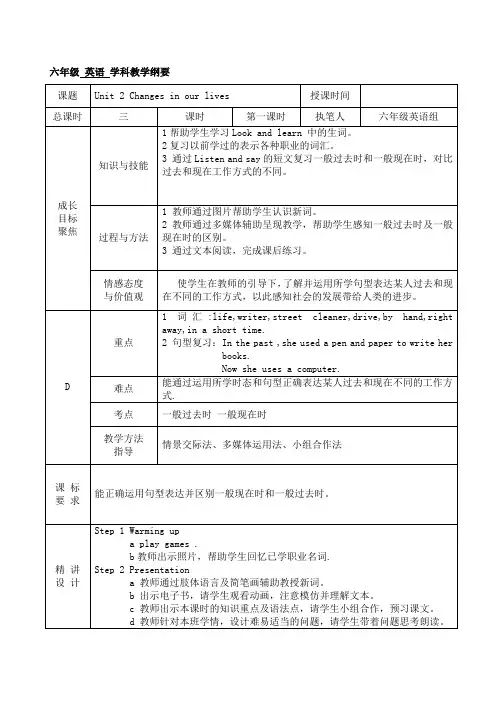
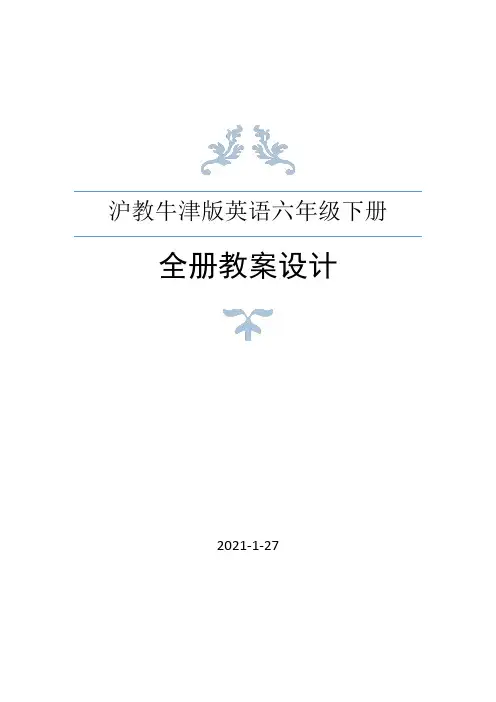
沪教牛津版英语六年级下册全册教案设计2021-1-27Module 1 Changes and differencesUnit 1 You and me◆教材分析This lesson about each other, high weight and after-school life topic, enhance the mutual exchange of students.◆教学目标【知识目标】Learning the core vocabulary of the unit.Through the investigation task, let the students use the language in the real situation.【能力目标】Through Look and read, it helps students to use the general present time and the. There be sentence patterns to introduce the living environment and its differences.【情感目标】Increase the mutual understanding and communication of the students.◆教学重难点【教学重点】Word: centimetre, kilogram, weigh, fan, go fishingSentence: I’m 150 centimetres tall.I usually play football after school.【教学难点】How exciting! That’s fantastic!◆课前准备Tape recorder, Multimedia◆教学过程Step 1. Free-talkWhat do you usually do after school?I usually read books.I usually sing songs.I usually...Step 2. Look and learnHow tall is Joe/George?Joe is 150 cm.George is 152 cm.cm = centimetre1 metre1 metre = 100 centimetresStep 3. Ask and answerA: How long is your...?B: My ... is ... centimetres long.Step 4. Look and learnGeorge is 40 kilograms.Joe is 47 kilograms.How much do you weigh?I weigh… kilograms.weighStep 5. Listen and sayWho is taller?… is taller.Joe is visiting his cousin George in the countryside.Joe: I weigh 47 kilograms. How much do you weigh, George?George: I weigh 40 kilograms.Joe: I’m 150 centimetres tall. How tall are you?George: I’m 152 centimetres tall.Joe: You’re taller. Do you do a lot of exercise?George: Yes. I usually play basketball and table tennis after school. Joe: I usually play football after school. I’m a football fan.George: Sometimes I go fishing with my grandpa.Joe: How exciting! I don’t go fishing often. There’s no river near my home.George: But you can go to museums. That’s fantastic!Step 6. Ask and answerWhat do you always/usually/often / sometimes do after school?I ...Step 7. Think and sayThat's fantastic! So cool!How exciting! How amazing!How nice! Wonderful!That's great!Step 8. Look and readWho lives in the countryside?What do people do in a theatre?theatreStep 9. Read and completeThere are a lot of __________ and _____ in the city.There are a lot of _____ and _________ too.There are a lot of ______ with garden in the countryside.There are ____, _____, _____and _____.Step 10. Read and answer1. How do people go to work in the city?People go to work by ca r, bus or underground.2. What do they do at the weekend?At the weekend, some people enjoy themselves at the cinema or theatre. Some people visit museums or parks.3. How is the air in the countryside?The air is fresh.4. What do people do in the countryside?People here like to walk or ride their bikes. Farmers plant crops in spring. Then in autumn, they get the crops.There are ... in the countryside.Step 11. Class debateWhich is a better place to live in, the city or the countryside?Step 12. Let’s guessYao Ming, a basketball playerHeight: ( ) 215cm ( √) 226cm ( ) 229cmWeight: ( ) 123kg ( √) 140kg ( ) 135kgHobbies: ( ) write books ( ) play the piano( ) do exercise (√) play basketballStep 13. Do a interviewHow tall are you?I’m 165 centimetres tall.How much do you weigh?I’m weigh 51 kilograms.What do you do every?I do exercise every day.Do you live in the city or in the countryside?I live in the city.Step 14. Free talkDo you like city or countryside? Why?Step 15. Learn the sounds/ei/table make rain play/ai/Ice fire cry night tie heightStep 16. HomeworkRead the text aloud according to the correct pronunciation and intonation.Module 1 Changes and differencesUnit 2 Changes in our lives◆教材分析Through the story of the happy farmer couple, the student's reading ability is promoted and the students are helped to understand the truth in the story.◆教学目标【知识目标】Learn new words through Look and learn and review the words that have previously been learned to represent a variety of professions.【能力目标】The short passage of Listen and say reviews the general past and the general present, and compares the difference between the present and the past.【情感目标】Understand the truth of this story.◆教学重难点【教学重点】Vocabulary: life, writer, street cleaner, drive, by hand, right away, in a short time.【教学难点】Works and expressions for everyday use:I wish you a happy life.◆课前准备Tape recorder, Multimedia◆教学过程Step 1.Free-talkIn the pastNowStep 2. Look and l earnWriterphotographerstreet cleanerfilmdigital cameraStep 3. Listen and followMs Wen is a writer.In the past, she used a pen and paper to write her books.Now she uses a computer.Mrs Hong is a farmer.In the past, she got her crops in by hand.Now she uses a machine.Mr Zhang is a photographer.In the past, he used film to take photos.Now he uses a digital camera. He can see his photos right away.Mr Yang is a street cleaner.In the past, he swept the streets with a broom.Now he drives a street sweeper. It can clean the streets in a short time. Step 4. Role-playThe students play the role.Step 5. Learn the sounds/əu/o, o-e, ow/au/ou, owStep 6. Try to read/əu/told smoke row/au/house towerStep 7. Read a story1. Where did Fred and his wife live?They lived in a small, old house.2. Who visited them? What did she say?A fairy. She said she could give Fred three wishes.3. What did Fred and his wife wish for?They did not make a wish.4. What did the fairy wish them?She wished them a happy life.Step 8. HomeworkWrite all the main occupation and follow the noun sentence make a sentence.Module 1 Changes and differencesUnit 3 Our school in the future◆教材分析The undergraduate through the Do a survey task, further consolidate the use of the general.◆教学目标【知识目标】Review the verb phrases through Look and learn.【能力目标】Through the writing task of Think and write, it helps students to consolidate the ability to use the written expression in general future.【情感目标】It is the students who learn to look forward to their future life.◆教学重难点【教学重点】Vocabulary: mountain, even, spaceSentence pattern review:In the future, schools will be different.【教学难点】The writing and application of sentences in the future.◆课前准备Tape recorder, Multimedia◆教学过程Step 1. Think and sayMy school in the pastIn the past, our school was...There was/were...There wasn’t/weren’t...Students...My school nowNow, my school is...There is/are...What did Ms Guo ask the children to do?Step 2. Think and answerWhat’s a time box?What would you like to put into a time box?Step 3.Look and learnThe simple future tensewillbe going towill not/won’tbe not going toThe simple future tensetomorrownext Monday/week/...in the futurein the futurethis evening/Sunday/...will / won’tbe going to/be not going toWhere would you go for a picnic?What would you take with you for a picnic?Who do you want to have a picnic with?What do you need to grow a plant?soila shovelStep 4. Read and writeOn sunny days, I like to have a picnic with my family. We always brings a lot of food and go to the same park. But in the future, I thin k picnics will be different. First, you will get information on the computer. You will know the best place to have a picnic.When you get to the place, you can choose the food online and the restaurant will send you the food. Wouldn’t that be interesting?Step 5. Read aloudStudents will have a picnic every month.Students will study online at home.Students will grow a lot of plants in the garden.Students will not carry any books.All their books will be on a small computer.I will be the head teacher.Step 6. Think and sayStudents will...Students will not...I will be...Step 7. Guess and saySchools of the future.Step 8. Think and sayWhere will schools be?They will be under the sea, on high mountains and even in space.How do you find books now?How will you find books in the future?Robots will help us find books in the library.Step 9. Discuss and shareWhat else can robots do?Step 10. Read aloudRobots will help us find books in the library.They will also do other things in schools.Step 11. Read and completeWe use _____ in our lessons now.In the future, we will use _________ in all our lessons.Step 12. Think and sayWhat will you do with computers in the future?What will teachers be like in the future?They will be...Step 13. Class debateRules:1. Choose Group A or Group B.A: Computers will replace teachers in schools.B: Computers will not replace teachers in schools.2. Present your ideas one by one.3. Each one can present for 1 minute.Step 14. Think and writeIn the future, schools will be different.Step 15. Read and thinkLast week,I flew a kite in the park.I fly a kite in the park every weekend.Next week,I will fly a kite in the park.Step 16. Look and sayLastEveryNestStep 17. HomeworkComplete the letter and read it aloud.Module 2 Work and playUnit 4 Art◆教材分析Through the writing activities of Think and write, help students to further consolidate and use the core sentences; one of their favorite paintings.◆教学目标【知识目标】Look and teach helps students to learn new words and review similar words.【能力目标】By reading the story of Da Vinci painting, helps students to review the past, grasp the language of daily usage, and experience the story behind the truth.【情感目标】Help students to practice core sentence patterns and guide students to express the reasons for what they like.◆教学重难点【教学重点】Understand Da Vinci and his masterpiece Mona Lisa.【教学难点】Know more famous paintings and painters.◆课前准备Tape recorder, Multimedia◆教学过程Step 1. Think and saysubjectsChineseArtPEScienceEnglishMusicMathsStep 2. Look and guessThe students are going to an art museum tomorrow.Step 3. Ask and answerWhat can we see in an art museum?art museumsculpturepaintingStep 4. Read aloudThe students are going to an art museum tomorrow. Miss Wang is telling them about some paintings.The Browns __________ the park this Sunday.are going toThe Chens __________________ this summer holiday.are going to the beachMy mum _______________ tomorrow.are going to the beachStep 5. Ask and answerWhere are you going this weekend/next month …?I’m going to …Step 6. Think and change1. We will go to Beijing this summer holiday.We are going to Beijing this summer holiday.2. They are going to the park next Sunday.They will go to the park next Sunday.Step 7. Listen and answer1. Which painting does Kitty like? Why?She likes the one on the left because she likes the colours.2. What do you know about the paintings on the left?The painting on the left is an oil painting.It’s colourful.3. What do you know about the painting on the right?It’s a Chinese ink painting. It’s usually in black and white.4. Which painting does Joe like? Why?He likes the one on the right because he likes horses.on the lefton the rightStep 8. Ask and answerLook. Which bear do you like? Why?I like the one … because …Which story do you like? Why?I like the one … because …Which house do you like? Why?I like the one … because …Step 10. Look and sayWhat kind of paintings are they?How do you know?Which painting do you like? Why?Can you draw well?Step 11. Look and guessWhat was Little Leo doing?He was showing his picture to his friends. What did his friends think of his picture? They thought it was wonderful.Step 12. Read and answerWhat did the teacher ask Little Leo to draw?The teacher asked him to draw an egg.Did Little Leo think it was difficult?No. He thought it was easy.Step 13. Look and learnhappy unhappyusual unusualhealthy unhealthylucky unluckyStep 13. Read a storyLittle Leo worked very hard and became a great artist.Step 14. Think and discuss1. If you were Little Leo, would you listen to the teacher and draw an egg again and again?2. Does your teacher ask you to do something boring again and again?3. What do you learn from the story?Perseverance leads to success!Step 15. Retell the storyStep 16. HomeworkMaster the sentence patterns in this class.Module 2 Work and playUnit 5 Crafts◆教材分析Through the Listen and say situational dialogue, help students to review the Wh-questions and the present time, talk about hand making.◆教学目标【知识目标】Through Look and learn, students can help students learn new words and review similar words.【能力目标】Through the language output column of Make and say, the topic language is consolidated.【情感目标】Learn how to sum up the story and cultivate the spirit of thinking.◆教学重难点【教学重点】To cultivate students’ reading ability through the story “Luban and the saw”.【教学难点】Learning to describe the handmade process.◆课前准备Tape recorder, Multimedia◆教学过程Step 1. Look and learnWhat do you need in a crafts class?Glue.What do you need in a crafts class?Scissors.What do you need in a crafts class?Tape.Step 2. Let’s learnIt’s raining outside.What do you need?Who are they?What are they doing?Step 3. Listen and followThe students want to make presents for their families and friends.Ms Guo is helping them.Ms Guo: What do you want to make, Jill? What do you need?Jill: I want to make a crown. I need a pair of scissors.Ms Guo: That sounds nice. Who is it for?Jill: It’s for my little cousin. She wants to be a princess.Ms Guo: What about you, Peter? What are you making?Peter: I’m making a toy plane for my brother. He likes playing with toy planes.Ms Guo: That’s good. What are you making, Joe and Alice?Joe & Alice: We’re making a model house. It’s for Kitty. Her birthday is coming. We don’t have any tape. Can you give us some, please?Ms Guo: Sure!Step 4. Role-playLevel1:分角色朗读对话,注意模仿语音语调。
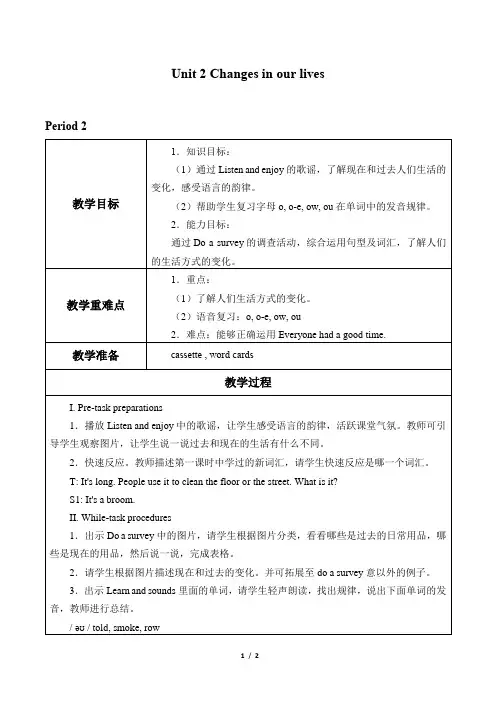
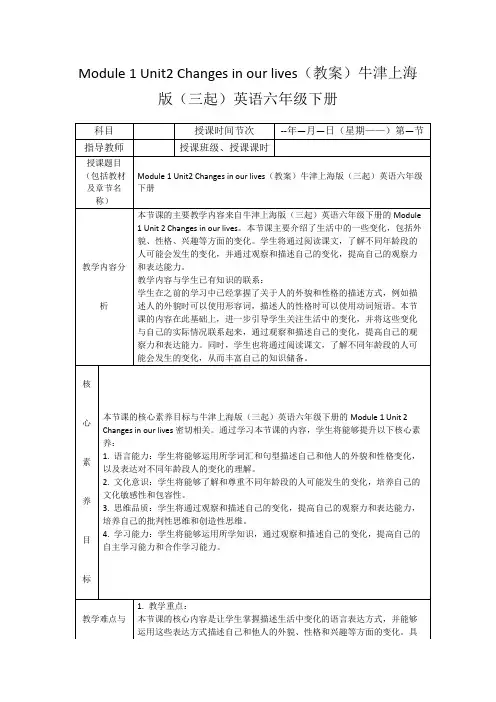
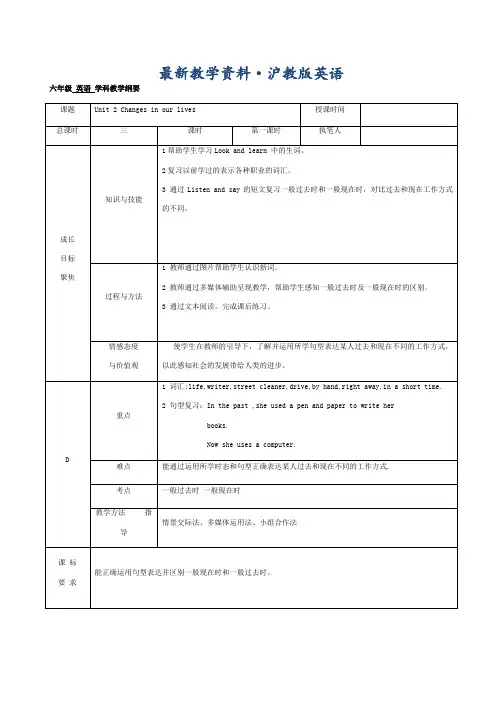
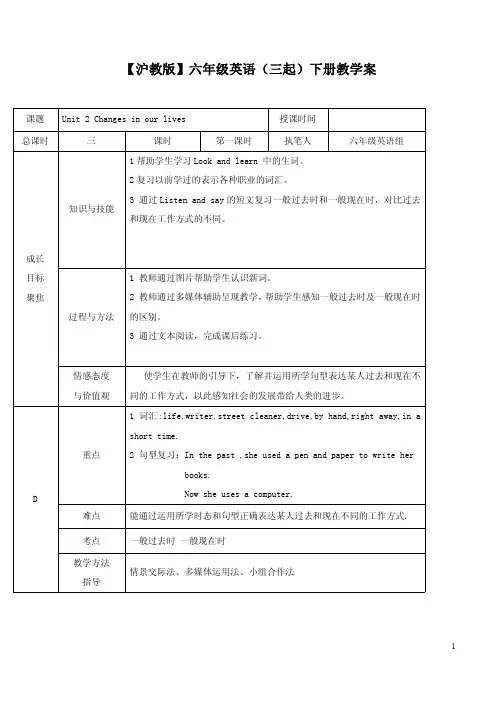
【沪教版】六年级英语(三起)下册教学案课题Unit2Changes in our lives授课时间总课时三课时第一课时执笔人六年级英语组成长目标聚焦知识与技能1帮助学生学习Look and learn中的生词。
2复习以前学过的表示各种职业的词汇。
3通过Listen and say的短文复习一般过去时和一般现在时,对比过去和现在工作方式的不同。
过程与方法1教师通过图片帮助学生认识新词。
2教师通过多媒体辅助呈现教学,帮助学生感知一般过去时及一般现在时的区别。
3通过文本阅读,完成课后练习。
情感态度与价值观使学生在教师的引导下,了解并运用所学句型表达某人过去和现在不同的工作方式,以此感知社会的发展带给人类的进步。
D重点1词汇:life,writer,street cleaner,drive,by hand,right away,in ashort time.2句型复习:In the past,she used a pen and paper to write herbooks.Now she uses a computer.难点能通过运用所学时态和句型正确表达某人过去和现在不同的工作方式.考点一般过去时一般现在时教学方法指导情景交际法、多媒体运用法、小组合作法课标要求能正确运用句型表达并区别一般现在时和一般过去时。
精讲设计Step1Warming upa play games.b教师出示照片,帮助学生回忆已学职业名词.Step2Presentationa教师通过肢体语言及简笔画辅助教授新词。
b出示电子书,请学生观看动画,注意模仿并理解文本。
c教师出示本课时的知识重点及语法点,请学生小组合作,预习课文。
d教师针对本班学情,设计难易适当的问题,请学生带着问题思考朗读。
e请个别同学回答问题,以此检查学生自主阅读的情况。
f再次播放录音,学生跟读,鼓励学生注意模仿语音语调。
g学生自主完成课后练习,教师订正指导。
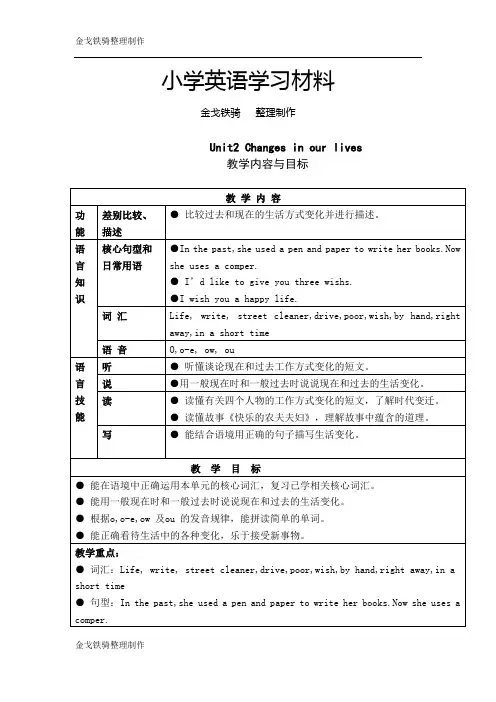
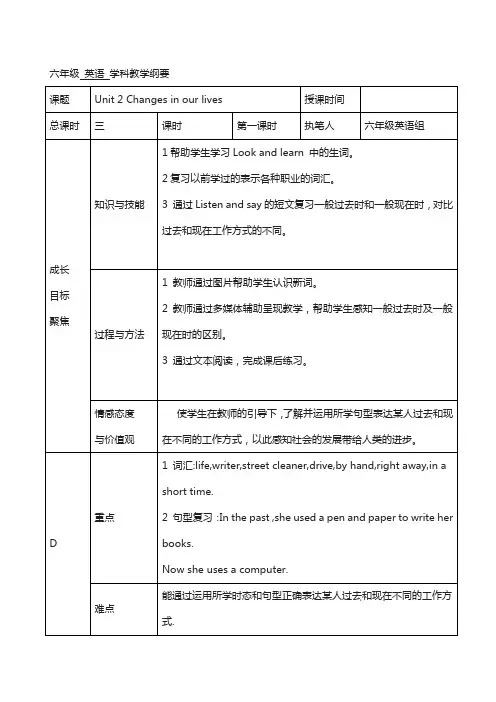
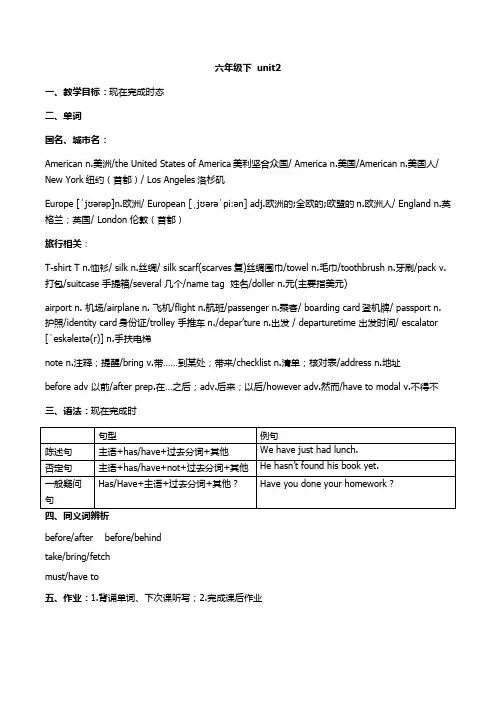
六年级下 unit2一、教学目标:现在完成时态二、单词国名、城市名:American n.美洲/the United States of America美利坚合众国/ America n.美国/American n.美国人/ New York纽约(首都)/ Los Angeles洛杉矶Europe [ˈjʊərəp]n.欧洲/ European [ˌjʊərəˈpiːən] adj.欧洲的;全欧的;欧盟的n.欧洲人/ England n.英格兰;英国/ London 伦敦(首都)旅行相关:T-shirt T n.恤衫/ silk n.丝绸/ silk scarf(scarves复)丝绸围巾/towel n.毛巾/toothbrush n.牙刷/pack v.打包/suitcase 手提箱/several 几个/name tag 姓名/doller n.元(主要指美元)airport n. 机场/airplane n. 飞机/flight n.航班/passenger n.乘客/ boarding card登机牌/ passport n. 护照/identity card身份证/trolley 手推车n./depar’ture n.出发 / departuretime 出发时间/ escalator [ˈeskəleɪtə(r)] n.手扶电梯note n.注释;提醒/bring v.带……到某处;带来/checklist n.清单;核对表/address n.地址before adv 以前/after prep.在…之后;adv.后来;以后/however adv.然而/have to modal v.不得不三、语法:现在完成时before/after before/behindtake/bring/fetchmust/have to五、作业:1.背诵单词、下次课听写;2.完成课后作业。
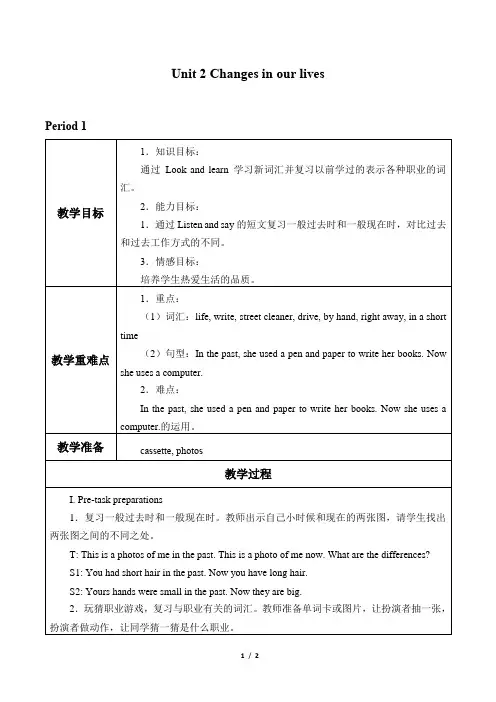
六年级下U2Ⅰ. Words.1. airport n.机场e. g.-Our father is coming to Shanghai by air.我们的父亲要乘飞机来上海。
-I'll meet him at the airport.我会去机场接他。
2. Los Angeles n.(美国城市名)洛杉矶e. g. Los Angeles has a population of 3,485,398.洛杉矶的人口是34853980。
3. before adv.以前e. g.-Have you been to Shanghai before? 你以前去过上海吗?-No, this is my first time.没有,这是第一次。
【知识拓展】before prep. 在……前面e. g. In the alphabet, A is before all the other letters.在字母表中,A排在所有字母前面。
4. T-shirt n. T-恤衫e. g.-These T-shirts are lovely.这些T恤衫真好看!-Yes, I'll buy one.是啊,我要买一件。
5. several adj.几个;一些e. g. There are several apples on the table.桌子上有几个苹果。
-You seem to know each other well.你们好像很熟。
-Yes. We've met several times.是的,我们见过几次了。
6. however adv.然而;不过;仍然e. g. She felt ill, however, she went to work.她病了,然而她照旧去上班。
Later, however, he decided to go.后来,他仍然决定去了。
7. pack v.装(箱);打(包)e. g. Don't forget to pack your toothbrush.别忘了打包你的牙刷!All these books need to be packed into boxes.这些书都要打包(装箱)。
Module 2 ChangesUnit 2 Seasonal changes教学目标:1.复习用句型like doing…表示“喜欢做……”2.复习用why询问原因,以及用because回答。
3.复习用介词with构成的介词短语作定语修饰名词。
教具准备:small blackboard radio cards课时安排:三课时第一课时教学过程:Step 1: Show the subject and the aims.1. Greetings.2. Show the subject and the aims.T:Boysandgirls,todaywe’regoingtolearnModule2ChangesUnit 2 Seasonal changes(板书)Here are our aims, they are…(利用小黑板出示学习目标)Learn aims:1.学习本课的单词。
Step2:第一次先学后教先学:Show the learn guide one:请同学们自己先根据单词后面的音标进行拼读单词。
Iwillgiveyouaboutfiveminutes,thenwe’ll check up.后教:1、指名学生自己读单词,先让其他同学帮助解决,必要时教师再作指导。
2、师领读单词。
3、学生边拼边读单词。
4、English and Chinese.Step3:第二次先学后教先学:Show the learn guide two:请同学们边拼读边记忆单词。
I will give you about eight minutes,then we’ll check up.后教:1.English and Chinese,Chinese and English.2.指名学生提问指名学生回答。
3.师出示汉语意思学生抢答。
Step5:Homework背写下本课的单词。
课后反思第二课时教学过程:Step 1: Show the subject and the aims.1. Greetings.2. Show the subject and the aims.T:Boysandgirls,to daywe’llcontinuelearnModule2ChangesUnit2Seasonalchanges(板书)Hereareouraims,theyare…(利用小黑板出示学习目标)Learn aims:1.复习用句型like doing…表示“喜欢做……”2.复习用why询问原因,以及用because回答。
学科教师辅导教案讲义编号: 组长审核:Read (读)read read ⑵AAB型(动词原形与过去式同形)(3) ABA型(动词原形与过去分词同形)(4) ABB型(过去式与过去分词同形)(6)情态动词的过去式到现在的动作或状态。
时间状语:already、ever、yet、not yet、just、just before ,in the past/last few years fo叶一段时间,Since+过去某个时间点基本结构:主语+have/has+do ne否定形式:主语+haven' t/hasn' t+done一般疑问句:have/has +主语+done动词过去分词的构成,这里只谈规则动词,既过去式与过去分词都是加-ed的。
有下面四种情况:1.一般的也是绝大多数的动词是直接在后面加-ed,例如,PIayed2.以e结尾的动词只加-d,例如,loved3.以辅音字母+y结尾的,变y为i再加-ed4.以一个辅音字母(r/w/y除外)结尾的重读闭音节,要双写这个辅音字母再加ed,例女口,stopped, planned, Preferred等。
already 已经。
(多用于肯定句,放在动词前)yet也,还。
(多用于否定句和疑问句,放在句末)just 刚刚。
(和already用法相同)五.点动词(又称瞬间动词)不能与一段时间连用及其转化的几种方法:例如:come go leave begin buy join CatCh arrive borrow Iend die 这些点动词不能与一段时间连用。
(注意:但在否定句中点动词能与一段时间连用。
如:l haven ' received a Ietter from Jim for a long time.{receive 是点动词})转化的几种方法:1.点动词转化为其它延续性动词。
女如: I have had a Cold Since One day ago .(CatC 是点动词,转化为延续性动词have,其过去式为had )2. 点动词转化为 “ be 名词”女口: He has been a solider for 3 years.3. 点动词转化为 “ be 介词”女口: He has been in the army for 3 years .4.点动词转化为“ be 副词”女口:Tom has bee n away 离家)for a few days.5.点动词转化为“ be 形容词”女口:That old man has bee n dead for SeVeraI years.6.原句转化为“ It ' s/It 时间段+since+…”如:It is 3 years SinCe he joined the army.7.原句转化为 “ It ' S been/lt has b 时间+段+since …。